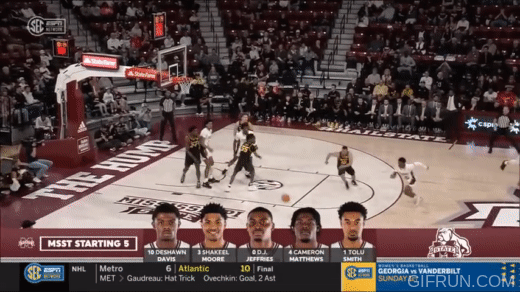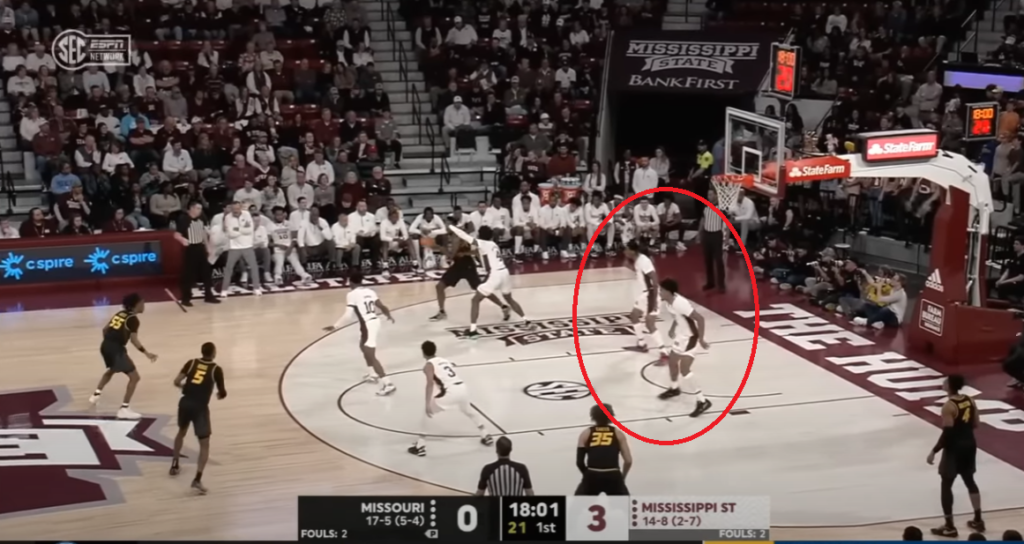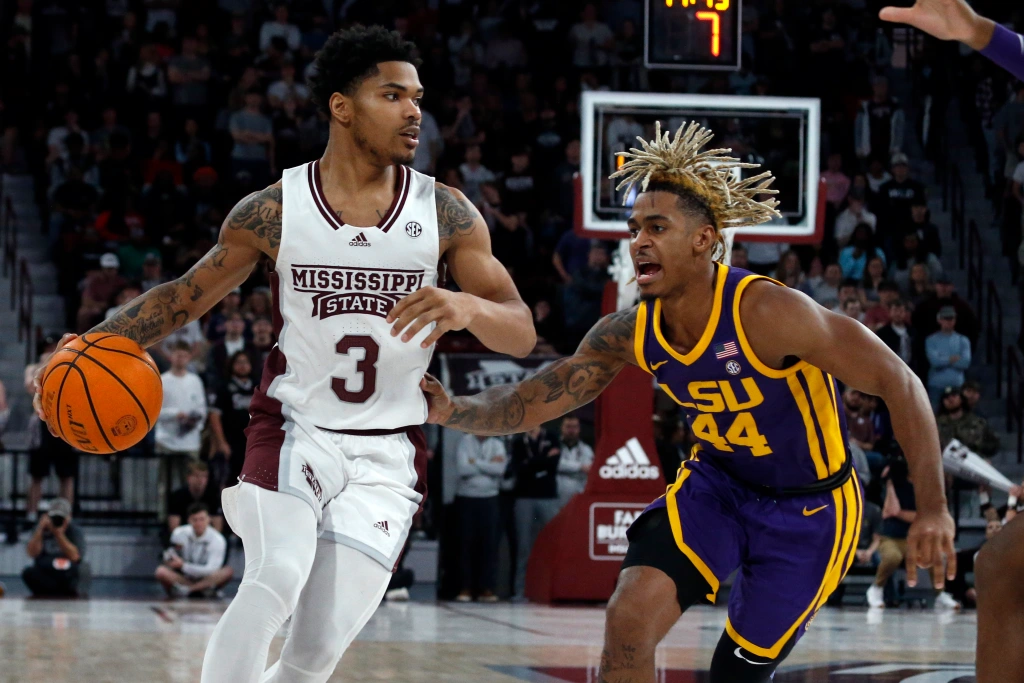As a follow-up to a monster win over Kentucky and with more Nick Smith return rumors swirling, the Hogs walk into a huge trap game on Saturday against Mississippi State. The Bulldogs aren’t good, but they’re good enough to make this game very interesting, especially if the Hogs aren’t focused.
Meet the Bulldogs
State gave Ben Howland the axe after last season and hired New Mexico State’s Chris Jans, whose last game with the Aggies was a 58-53 loss to Arkansas in the second round of the NCAA Tournament. As that game implies, Jans is a defensive-minded coach who likes very slow pace and very ugly basketball. As Mississippi State is one of the worst jobs in the SEC in terms of history, recruiting ground, facilities, and fan interest, hiring a coach like Jans to just muck every game isn’t a bad idea. We thought this was a nice hire at the time.
So far, things aren’t going badly in Jans’ first year.

After an 11-0 start against a cupcake schedule, the Bulldogs found reality in the SEC, starting 1-7 in conference play. But they’ve won three straight SEC games – two against bottom-feeders South Carolina and LSU – and also upset a very good TCU team in the SEC-Big 12 challenge. They’re pretty far off the bubble right now, but a win in Fayetteville at least starts the conversation.

Model pick: Arkansas 66, Mississippi State 60. The Bulldogs have a top-10 defense and play at a brutal pace. This game might not be aesthetically-pleasing.
Scouting Report

For State, it’s all about Tolu Smith, the 6’11 senior who is the Bulldogs’ only player averaging double figures in scoring. He has a monstrous 30% usage rate (that’s JD Notae level) on offense and a 99 DRAPM grade, so he is the total x-factor at both ends.
Smith is a foul magnet (24% free throw usage), a good passer for a big man (11% assist rate), and, most importantly, an elite offensive rebounder (16% offensive rebound rate). Like Kentucky’s Oscar Tshiebwe, he’s not an elite shooter, hitting just 58% despite the fact that almost all of his shots come around the rim, but his positive impact comes from his volume. He will turn it over a little too often (19% turnover rate) and he’s not quite as active defensively as you’d like (just 2.8 kills per 40 minutes… roughly one-third of what Makhel Mitchell will do on defense per 40 minutes). Other than that, there are few knocks against him.
The Razorbacks had success against Kentucky by working to shut down Tshiebwe and making Kentucky’s role players produce. The good news is that strategy is very viable here, and the payoff will be even larger: State has no Cason Wallace, or anyone particularly close. The Bulldogs are among the nation’s worst jump-shooting teams.
The next-biggest-threat is Smith’s frontcourt mate, 6’7 senior DJ Jeffries. On offense, Jeffries is mostly a perimeter player, and his numbers are ghastly. He’s hitting just 38% eFG% and grades at a horrendous 13 ORAPM. About half his shots will be 3-pointers, and he’s a cool 28% on those. That’s barely enough to warrant covering him on the perimeter, but his real problem is that there’s no follow-up: he’s around 40% on shots inside the arc, mediocre at getting to the line (18% free throw usage), and bad at offensive rebounding (4%). He’s much stronger defensively.
The backcourt is much stronger, starting with 6’1 Shakeel Moore, who has a legitimate claim to be the SEC’s best defender. His DRAPM is 14th-best among all Division I players, and his 6% steal rate is the 2nd-best in the whole country. Moore isn’t very good on offense, as his shot just hasn’t fallen this season, but his defense makes him a major key for the Bulldogs. Fellow point guard Dashawn Davis, a 6’2 transfer from Oregon State, is the Bulldogs’ only 3-point threat, hitting a solid 39% on the year. He undoes a lot of his good shooting work by turning it over on 23% of his possessions, and he is a mediocre defender.
The final piece is 6’7 jumbo guard Cameron Matthews, a very good perimeter defender and steal machine (4% steal rate). At his best on offense, he’s a poor man’s Ricky Council IV: a guard able to use his height to create shots at all three levels. But emphasis on the “poor”, as he’s hitting just 14% from beyond the arc.
The bench is very thin, as the top three guys off the bench all grade as major liabilities. 6’2 guard Eric Reed shoots an awful 38% eFG%, 6’8 forward Tyler Stevenson is a very good defender, but his low shooting percentage around the rim (47%) and inability to draw fouls (11% free throw usage) are holding him back, and 6’11 center Will McNair doesn’t contribute much at either end.
When Mississippi State has the ball

Both defenses have a matchup advantage in this game, but Mississippi State’s offense is really awful, which will hold them back. They play at a very slow pace (271st) and outside of cashing in turnovers for quick points (10th), they get nothing in transition (207th). Their halfcourt offense is not just atrocious but it is pretty bad.

The reason for the bad offense is, very clearly, jump shooting. The Bulldogs are probably the worst jump shooting team in all of major college basketball, ranking 359th in 3FG% and 354th in midrange FG%.
So they do all the things you’d expect a team with a talented big like Smith and bad shooters to do: they crash the rim. They are good at getting to the line (57th), good at offensive rebounding (24th), and good at making shots around the rim (35th). They are also decent at getting those rim shots off in the first place (90th).
The problem State will have is that if Smith is shut down, there are no other reliable options. Four of State’s top six minutes-getters take at least 46% of their shots from beyond the arc. Every possession is all about getting Smith the ball, and he’s not going to create a ton for himself. He’s at his best when he can get a deep post entry:

It’s easier said than done, but just taking away that entry pass will force State’s offense into some unsavory shots.
When Arkansas has the ball

It will be stunning and disappointing if Arkansas is unable to shut down State’s offense, but I would not at all be surprised if the Hogs struggle mightily on offense themselves. The Bulldog transition defense is just good enough, and they rely on elite halfcourt defense to give them a chance.

You can see what makes State so good: they keep you away from the rim (15th in rim usage) and instead force a lot of 3-pointers, and then they defend those well (54th in 3FG% defense).
State’s defense is a man-to-man scheme that includes elements of several schemes. It is primarily aimed at preventing easy shots around the rim. From the pack line, we’ll see one-pass-away defenders stunting at the ball to prevent dribble penetration. From the no-middle, State will rotate backside defenders into the post to gain a numbers advantage to one side, like this:

Basically, there is a lot of help defense from the Bulldogs, especially when it can prevent a drive to the basket. The downside of this is that they tend to allow a lot of open and semi-open 3-point looks if you can get good ball movement.
So the real question is, can Arkansas get to the rim? State will go under on ballscreens, ceding the pull-up jumper but preventing the dribble drive. If Arkansas settles for too many jumpers, this game could end up being a low-scoring brickfest by both teams.
I think you’ll see a lot of pick-and-rolls, particularly with Black working with one of the Mitchells. This game is a great opportunity for the Mitchells to be major factors offensively. Parking a big in the dunker position (below the block) and letting him go up for an oop or dump-off when his man helps on the drive is another good play. And then kickout 3-pointers will be available as well, if the Hogs can hit them.
This game does scream Black more than Council: Black is best on those pick-and-rolls, while Council is more of an iso player. State won’t give up a ton of isolations, as they will be content to help on the ball and give up a potential jump shot.
Keys to the Game
- Take Tolu away. Tolu Smith is State’s only real offensive weapon. If the Hogs can prevent him from dominating in the low post, the Bulldogs really don’t have many offensive options.
- Avoid costly turnovers. Cutting down on turnovers – especially dumb, unforced ones – was a major factor in Arkansas’ win at Kentucky. State is going to force a few, but the Bulldogs’ defense is their best offense, so turnovers will hurt the Hogs double. Those need to be limited as much as possible.
- Don’t settle for long jumpers. Arkansas’ offense has improved against “pack it in” defensive looks, but the Hogs still almost lost to South Carolina and their 1-3-1 zone. The Hogs’ inability to hit jump shots and tendency to settle for them could be a problem.
Thanks for reading! Be sure to follow us on Twitter and on Facebook.
The latest from Fayette Villains, straight to your inbox
Enter your email to subscribe and receive new post alerts and other updates. You can unsubscribe at any time.
